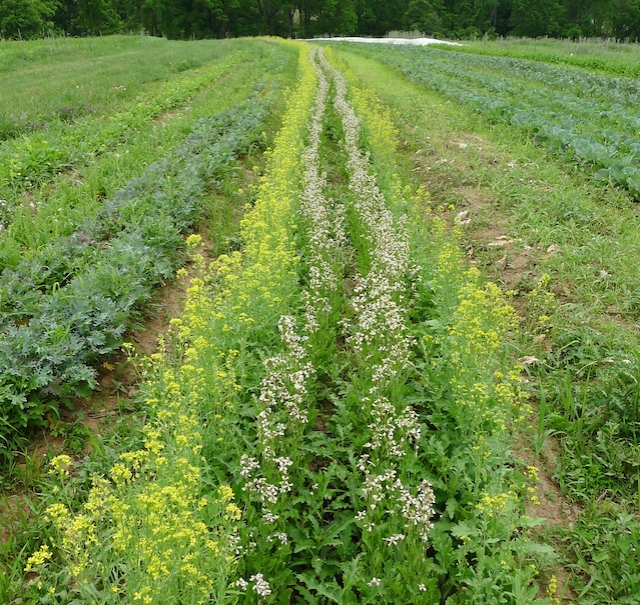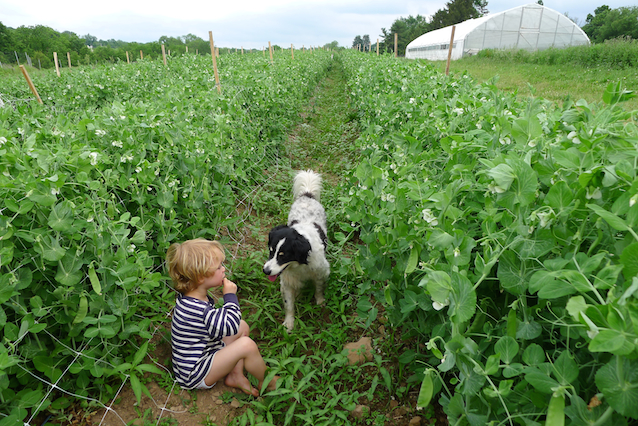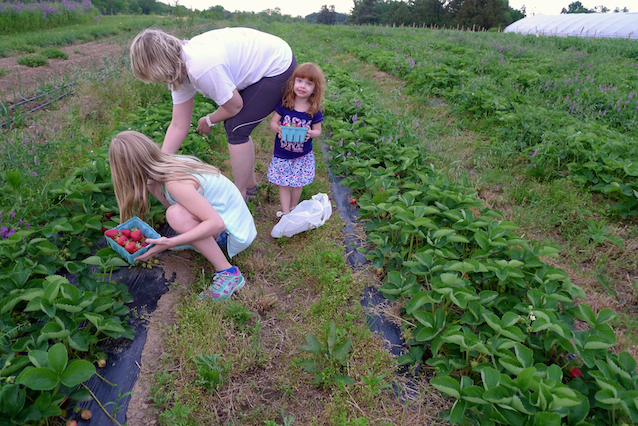Hello June
The pea trellising system this year has vastly improved the u-pick experience through the use of a simple solution: plant the pea rows 1 foot apart instead of 2, allowing for more walking room. The peas don't seem to mind.
Delectable and nutritious, strawberries have to be one of the best crops selected, bred, and improved by lovers of plants. The 3- or 4-week long strawberry season is not to be missed, but will be missed when it is over.
News
Expected Harvest
Beets with Greens, Peas
By Derek McGeehan
Harvest #4 (Week B) should include beets, kohlrabi, kale, chard, romaine, butterhead, and mini lettuces, endive, escarole, Italian dandelion, dill, cilantro, baby kale, collards, mizuna, and mustard greens. Some items will be a choice. U-pick should include snow peas, strawberries, and perennial herbs.
Notes From The Field
In the Midst of the Busiest
By Derek McGeehan
Last week the quantity and pace of work seemed to double and our amazing crew responded in kind. Everything has been growing exponentially with the long days, heat, and little bit of rain. Weeds, crops, bugs, everything has recognized that it is truly safely late spring and is attempting to maximize activity during the brief months between frosts and cold. Our job is to stay on pace and to forever try to get ahead. It is very easy to feel overwhelmed and get behind on the job list. But, after walking the farm this morning while making our weekly job list, it feels like we're currently in a safe position. If the rain skips us today, or the storms are too severe for our liking, we may reevaluate. This time of year the job list is basically infinite, but with proper planning and prioritizing - which is aided by the experience of farming here for 8 seasons now - we're able to cope and hopefully mostly keep our cool.

What happens to those spring greens after they're cut? Like most living things they try to reproduce, and at least the mizuna, arugula, and broccoli raab pictured above attract beneficial insects and are nice to look at.
Soon we'll transition from a lot of planting to a lot of harvesting, crops like garlic, onions, potatoes, squash, tomatoes, peppers, eggplant, that only go in the ground once but are harvested over extended periods of time. So far the season feels like a good one and hopefully it will stay that way. Give us ample rainfall, normal bug and disease pressure, few 90 degree days, no 90+ degree days, no hurricanes or tropical storms, and we'll make it through with robust yields of healthy organic crops. I'm excited that beets are here, carrots are close, garlic scapes are starting to show, and peas are ripening. What better way is there to spend one's time than around the immediate gratification derived from fresh and tasty food?
Workshifts This Week
Half of your committed work hours should be completed by the end of July! Over the course of the season full shares work 8 hours; half shares work 4 hours. If you're unable to contribute the physical portion of your share, you may contribute to the farm financially at the rate of $15/hour. This fills out the balance of your share cost.
This week we'll harvest carrots, pull weeds, and probably cultivate. Beat the heat by coming in the morning!
Tuesday 7/19 8-10am; 10am-12noon
Wednesday 7/20 8-10am; 10am-12noon; 6-8pm
Friday 7/22 8-10am; 10am-12noon
Saturday 7/23 8-10am
Baby flycatchers nestle on a beam in the Walnut Barn. A parent or two made a beautiful nest, including some orange straw bale twine.
2016 Workshop #1: Now What?! Please join us on Saturday, June 11th from 1 to 3 PM.
Written and to be hosted by longtime farm and core group member Gia.
Maybe you are a new member. Maybe you’ve been a member for a while. Either way – this workshop is for you!
In the barn, everything made sense while you were putting your share into your bags to bring home. At home, it suddenly became very overwhelming once you began unpacking! We have all been there; it is part of the CSA learning curve.
Let us help you make the most of your farm share!
Being a member of a CSA opens the door to so many topics! At this workshop we will talk about:
- Resources: books, websites, Anchor Run CSA website (Recipes and Veggies 202 – it has pictures!!)
- How to keep your veggies as fresh as possible once they are in your refrigerator.
- The pros and cons of different preservation techniques (freezing, canning, dehydrating).
- “Tools of the trade”, which I find invaluable.
- Before you compost: radish greens are edible!
- Composting: Composting at the farm; what to and not to include in a compost pile; vermicomposting.
- Solar Cooking
We will share recipes that our families love, recipes that include farm produce. And by share – I mean taste and provide copies of the recipes. Pestos - don’t limit yourself to Basil! What to do with all that Bok Choy! Veggie Hash! The list goes on!
Introducing Adam, Assistant Farmer
I grew up in Doylestown without any farming background. I first got into farming while a philosophy student at Penn State, when I realized I was craving more authenticity in the way I lived my life. I ended up apprenticing on a small organic farm in central PA, and it didn’t take long for me to realize this was what I had been missing in my life. There is nothing in the world like farming - being connected to nature, working outdoors every day, building a relationship to the soil and the land - what could be better? I ended up apprenticing for three seasons on that farm, learning the basics of organic farming and getting steeped in the amazing sustainable agriculture community of PA.
For the last eight years or so I have mostly lived and worked abroad - first teaching English in China, then living at an ecovillage in Thailand, where I started getting into permaculture (a system of applied agro-ecological design). I eventually went to Sweden for two years where I received a master’s degree in environmental science and met my eventual wife, Sunghee. I went back to Thailand to increase my skills in permaculture design and later moved to The Bahamas to work as a permaculture and aquaponics farm manager for a nonprofit school.

Last year, Sunghee and I moved back to Bucks County permanently to start our own organic farm with my family. We ended up settling on a ten-acre farm in Buckingham off Holicong Road, and I’m now working on developing our farm, Hundred Fruit Farm. Our farm will mostly specialize in organic u-pick fruit, berries, mushrooms, pastured meats, free range eggs, and educational workshops. I’m especially excited about growing unusual fruit like paw paws, honeyberries, cornelian cherries, bush cherries, elderberries, asian pears, and other weird stuff.
I’m thrilled to be working at Anchor Run this year as a part-time assistant farmer, helping grow vegetables for this wonderful CSA right in my own proverbial backyard, while developing my own farm in my free time. I can tell that Dana and Derek are really fantastic farmers and great people (who I’ll surely learn a lot from), and I’m looking forward to meeting all the community members that make this fantastic farm possible.
Salad Days
By Linda Dansbury
You may be wondering what to do with the vast quantity of lettuces you are receiving with your share right now. If you typically use the same salad dressing recipe every time you prepare a salad, you might get bored of the repetitiveness. Check out this website for a multitude of dressings and variations on vinaigrettes that will keep your tastebuds happy. There is a basic vinaigrette with a number of variations, balsamic vinaigrette, lemon-chive and it goes on and on. Just go to the website, click on "Members Page". Then select the tab that says "Search". In the pull down bar select "Recipes" and type in "dressing" or "salad" and you will see the listing.
I almost think of lettuces as the main vegetable in a meal and try to match the dressing with what we are having for dinner. For example, if we are having a meal that is comprised of Asian flavors, then my salad dressing will have sesame oil and/or tamari/soy sauce in it. With the start of peas, I will add peas either raw or flash boiled for 1-2 minutes. With a steak, I might make a Caesar salad. Experiment with different greens, veggies and combinations of flavors - fresh herbs add great pops of flavor to salad dressings. If you have a favorite way to prepare your salad greens, please email me at lindadansbury@comcast.net so I can share it with the rest of the members.
Beets are here
By Linda Dansbury
Over the many years I have been writing for the farm, the public's knowledge and taste for various vegetables have truly evolved. In the beginning, most people really didn't know what to do with things like kale and chard. Now with juicing and smoothies being so popular, even if those greens are too much to prepare and eat as part of a meal, I often hear members say "Oh I will juice these greens". Or "My kids love smoothies with kale".
The same thing has happened with beets - most folks used to say that they didn't like beets, but now they are happy and excited when beets appear. I particularly like them early in the season when they are small and sweet. Beets are so nutritious and so much can be done with them. As with turnips, separate the greens from the beets and store separately. The greens can be used with other greens in stir fries and saute's and there are a couple of recipes on this site that incorporate both together, such as Roasted Beet and Beet Green Risotto and Roasted Beets and Beet Greens. If we receive beets without their greens, Swiss chard is a great substitution, because they are in the same family. Again, search this site for great ideas and recipes.
Beets keep a long time stored in the fridge or pickled, but again, at this time of year I actually like to use them quickly because they are sweeter. We love them roasted, sliced and mixed with greens in a beautiful salad with a Dijon mustard and tarragon dressing. Yummy!
Calling Home U-pick Containers!
By Linda Dansbury
The containers in the pick up room are a wonderful convenience and obviously the best way to accurately measure our shares of U-pick. Please pick one of these options so that Farmers D&D don't have to keep purchasing more containers:
Go to the U-Pick fields and pick your share and then empty the containers into a bag or suitable container that you bring with you, and return the containers to the pick up room; or, bring the containers home and when empty, place in the bag/container you bring with you to the farm and continue to re-use the same containers each week.
Over the year, I typically use a combo of these - for strawberries and cherry tomatoes I keep the containers because I don't put these into plastic bags for storage. Veggies such as peas, green beans and edamame are best stored in plastic sealed up, so I dump my share into my own bags at the farm and return these containers to the pick up room. I also save the containers from purchases I make at other locations and bring them to the farm to use.
Thank you for saving and re-using!
How I Enjoyed My Harvest
How I enjoyed my harvest this week
By Linda Dansbury
I missed a week's harvest due to travel and just picked up on Thursday so I haven't done a lot with my share yet. But here are a couple of things.
Swiss chard - I often use chard in place of spinach and saute it with garlic, salt and pepper, and a squeeze of lemon juice at the end. I often add a few red pepper flakes in the beginning with the garlic for a little "zing".
Romaine lettuce - We were grilling so we gave the entire head of romaine a light char on all sides and made it into a Caesar salad.
Kale - some of the kale I put into a smoothie, and the rest I made into Kale Chips - this is a very, very popular recipe on this site - just make sure the kale is perfectly dry before you bake it because it won't crisp up if it is wet.
How do you enjoy your harvest? Please email me at lindadansbury@comcast.net.
Recipes
V Kale Chips
There are lots of great recipes for hearty greens, but this one turns the veggie into an addictive snack. Maybe even the kids will eat kale this way! Serves 2.
1 pound kale
3 tablespoons extra-virgin olive oil
1 tablespoon apple cider vinegar
Sea salt, to taste
Parmesan cheese, grated - optional
Preheat oven to 350 degrees Fahrenheit.
Trim kale of tough stems and roughly chop leaves into potato chip-size
pieces. In a bowl, whisk together olive oil and vinegar. Toss kale in
olive oil and vinegar mixture, until thoroughly coated. Spread kale on
a baking sheet in a single layer and sprinkle with salt.
Bake 10 minutes, until leaves are crisp but not completely browned, stirring them at 5 minutes. Sprinkle with grated parmesan cheese if desired.
V Roasted Beets with Beet Greens
Wash beets and greens well. Cut off all but 1/4" of the tops, discard large stems, and set leafy greens aside.
Preheat oven to 375° F. Place beet bottoms (the roots with the bit of stem attached) in a roasting pan, toss with olive oil and add rosemary sprigs. Roast for about 40 minutes if they are baby beets, longer if they are big beets. Cook until just tender (can be pierced with a fork). Allow to cool slightly. Remove skin while warm, and cut beets in half.
Meanwhile sauté the beet greens in olive oil and add a splash of balsamic vinegar. Season the greens with salt and pepper and place on plate. Top with roasted beets and serve.
Roasted Beet and Beet-Green Risotto
Recipe by Marsha Shulman, 2008; makes 4-5 generous main course servings
3/4 pound beets (1 bunch small), roasted
1 bunch beet greens, stemmed and washed
6 to 7 cups chicken or vegetable stock, as needed
2 tablespoons extra virgin olive oil
1/2 cup finely chopped onion
1 1/2 cups Arborio or Carnarolli rice
2 garlic cloves, minced or pressed
1/2 cup red, rose, or dry white wine
Salt
Freshly ground pepper
1 to 2 ounces Parmesan cheese, grated (1/4 to 1/2 cup, to taste)
2 tablespoons finely chopped flat-leaf parsley
1. Bring the stock to a simmer in a saucepan. Season well and turn the heat to low. Stack the stemmed, washed greens and cut crosswise into 1-inch-wide strips.
2. Heat the oil over medium heat in a large nonstick frying pan or wide, heavy saucepan and add the onion. Cook, stirring, until the onion begins to soften, about 3 minutes, and add the rice and garlic. Cook, stirring, until the grains of rice are separate and beginning to crackle, about 3 minutes.
3. Stir in the wine and cook over medium heat, stirring constantly. The wine should bubble, but not too quickly. You want some of the flavor to cook into the rice before it evaporates. When the wine has just about evaporated, stir in a ladleful or two of the simmering stock (about 1/2 cup), enough to just cover the rice. The stock should bubble slowly (adjust heat accordingly). Cook, stirring often, until it is just about absorbed. Add another ladleful or two of the stock and continue to cook in this fashion, not too fast and not too slowly, stirring often and adding more stock when the rice is almost dry, for 10 minutes.
4. Stir in the greens and the diced beets, and continue adding more stock, enough to barely cover the rice, and stirring often, for another 10 to 15 minutes. Taste a bit of the rice. Is it cooked through? It should taste chewy but not hard in the middle. Definitely not soft like steamed rice. If it is still hard in the middle, you need to continue adding stock and stirring for another 5 minutes or so. Now is the time to ascertain if there is enough salt. Add if necessary.
5. When the rice is cooked through, add a generous amount of freshly ground pepper, and stir in another half cup of stock, the Parmesan and the parsley. Remove from the heat. The rice should be creamy; if it isn’t, add a little more stock. Stir once, taste and adjust seasonings, and serve.
Variation: I often blanch greens when I get them home from the market so that they won’t wilt or rot in the refrigerator if I don’t get around to cooking them right away. If you do this, and want to use them for this risotto, chop the blanched greens and set aside. Add them to the risotto during the last few minutes of cooking, just to heat them through and amalgamate into the dish.
Advance preparation: The roasted beets will keep for 5 days in the refrigerator. You can get ahead on the risotto, cooking it just through Step 3, then spreading the rice out in the pan or on a baking sheet. Reheat and proceed with Step 4 shortly before serving.
Yield: Serves 4 to 5 generously as a main dish



















